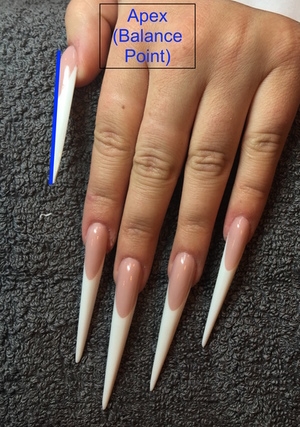
How to perfect proper nail structure
By Katie Barnes | 09 May 2017 | Feature, Technique

Salon owner, educator, former Scratch columnist and award-winning nail stylist, Katie Barnes, reveals the components of proper nail structure for a perfect nail finish…
While a nail enhancement featuring beautiful embellishments and nail art may look good to the eye at first glace; if the enhancement’s foundation isn’t sound then it will not have longevity and could cause damage to the underlying natural nail.
Consider the following for best results:
Form and tip fit
Forms or tips should be aligned perfectly with the side and the middle of the finger, regardless of the nail shape. Sometimes it is necessary to cut your form to tailor it to fit securely. Adhere tips completely flush to the free edge of the natural nail without any gaps. Tips should always be oversized rather than undersized as you can bring these in with a file. If you use a tip which is too small for the nail, as well as being uncomfortable to the client, a weakness is created.
Apex
There’s an even, gradual ascend from the cuticle area to the apex and then straight out or down to the free edge, depending on the nail shape that is being created. The apex is the highest point and thickest part of the enhancement; where the enhancement’s strength is. The apex should be visible from every angle. A properly built arch will allow the free edge and lateral structure to remain as thin as a credit card yet unbreakable. As the nail grows, the apex will move which is why maintenance appointments are crucial to adjust it accordingly.
Lateral Structure
Believe it or not, many expert nail techs have problems with their structure and achieving even sides. A nail tech can build a strong sidewall and then undo it with improper filing techniques. Files are intended to smooth and shape the nail surfaces as overfilling can create a weakness. Ideally, you should sculpt the nail with your brush and then use a file to level the product not to correct mistakes.
Sidewalls support the structure of the nail extension. First, a sidewall must extend straight out from the cuticle to the free edge on both sides. When you look at the nail from the side or the top, the sides should be straight. This means that you can’t favour one side or the other if you’re right- or left-handed; both sides must look the same.
Correct nail tech posture and positioning when working on your client is paramount, if you are not sitting straight, your nails will not be straight. It is important to learn and familiarise yourself with correct filing techniques and angles. Carry out the same routine on all 10 nails for consistency. It is necessary for the nail enhancement to have straight sides for longevity, and the key to achieve that is to maintain a straight file at the sidewalls when filing.
C-curve
Creating strong, symmetrical C-curves will bring durability to your nail enhancements like a bridge or archway, which pushes the support out to the side. The C-curve can be created with your form or by pinching the enhancement. Do not pinch the C-curve into the nail before it is ready, as you will affect the longevity of the product and create weak lateral sides.
It is paramount to ensure a full understanding of the techniques required for a strong and secure foundation so make sure you brush up on your techniques and skills for a long-lasting nail.
Love Katie B x


